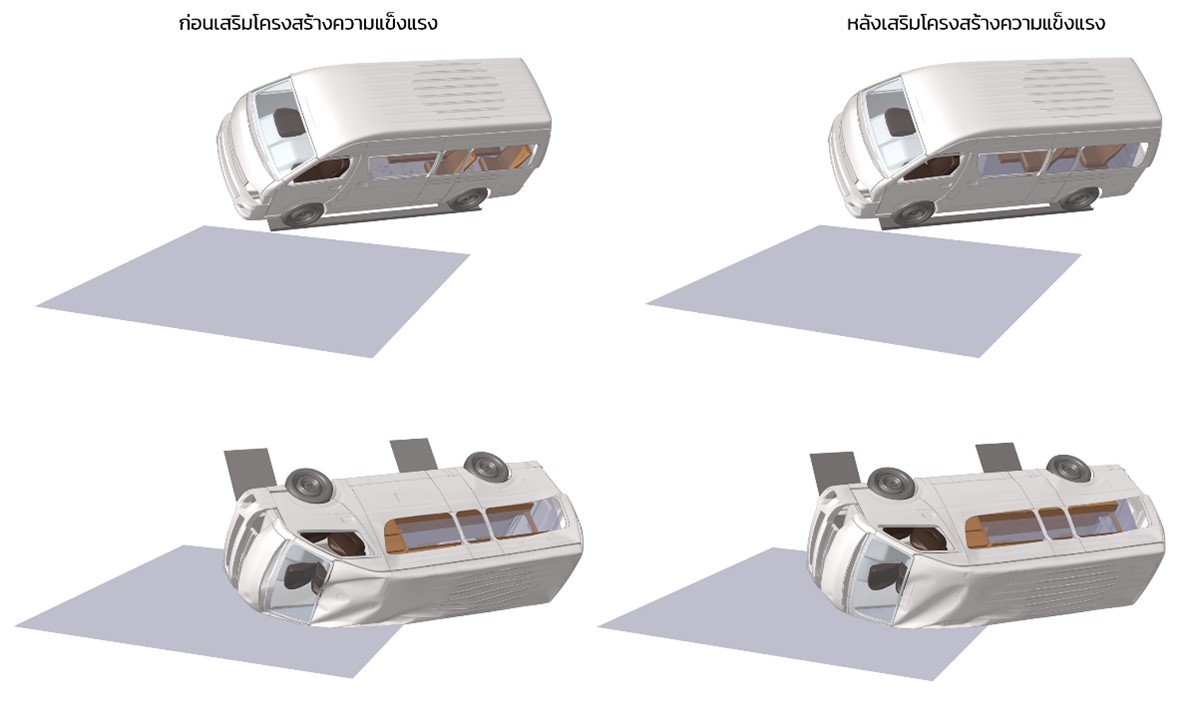

Name
Reinforced Superstructure Design of Ambulance Van Patient Compartment
Background
An ambulance is developed and used to transfer patients to a nearest nursing home or a hospital. In the meantime the trained ambulance personnel can provide the basic health-care treatment by using the emergency medical facilities and equipment present inside the ambulances.
Most of the ambulance compartment in Thailand is built and converted from commercial van by custom manufacturer. There are several constraints in the lack of safety design of the compartment, for example, low technology in design, a limit of production cost and an unclear national policy on road safety which result in road accidents, especially, a rollover accident. The injuries in the case of rollover are mainly related to the degree of roof crush and impact of the occupants on the interior (e.g. roof or pillars) of the vehicle.
One way to reduce occupant movement and ejection resulting in injury is to maintain an intact survival space by reducing roof crush of vehicles coupled with effective seatbelt restraint according to requirements adopted by UN R66 (the Economic Commission for Europe of the UN (UN/ECE) in its Regulations: No.66). UN R66 is in force to prevent the rollover accidents and thereby ensuring passenger safety for large passenger vehicles regarding the strength of their superstructure by establishing the requirements for passenger survival space (residual space) after the rollover incident happens. Here, the approval of a new structural-improved ambulance will carry out through numerical simulations with validated CAE methodology and correlate it with physical tests according to UN R66.
Goal
Cooperation between MTEC and Suprera Innovation Co., Ltd. research team to design and develop the reinforced superstructure according to UN R66 for ambulance rollover safety.
What did the research team do?
- Studied the technical restrictions for the design of ambulance van and established guidance to do the physical tests and the numerical simulations that can be used for rollover performance approval from the original design of the van.
- Adopted the second-hand van to obtain the original CAD for internal structures and exterior panels prior to install interior accessories for the modified van, including the installation of the physical survival space and sensors for measuring on deformed structures during the test.
- Conducted the rollover test of the baseline ambulance van (without reinforced structures), followed by UN R66, to evaluate whether the deformation behavior fulfilling survival space requirements. Collected the material samples for mechanical testing from the undeformed structures in many parts of the van as much as possible to find further the material properties for the finite element model.
- Simulated the 3-point bending test for the compartment pillars which are the important structures to resist the deformation from rollover test. The point of this test is to validate the finite element model and the physical test along with the available material properties and thickness, as model parameters, in a component test prior to simulate the full-scale test of the ambulance van.
- Captured the deformation and interaction of vehicle parts and subsystems occurring during impact by correlating results of numerical simulation with those of physical test of the full-vehicle models. This will also help in determining the weak areas and joints in structure which could be strengthened to ensure and improve passenger safety later.
- Designed the new structures with reinforcement to strengthen the compartment subject to the production cost, the production capability, and the on-site installation. Then the 3D models of those were created and rollover test was simulated. The validated numerical models were used to replicate physical tests for evaluating rollover performance and to carry out design iterations in ambulance structures for meeting rollover regulation.
- Adopted the second-hand van as the second trial for the physical rollover test. But the new structure with reinforcement including interior accessories and equipment were installed to prepare the new reinforcement design of ambulance for rollover test. Moreover, compare simulation and test result that confirmed an ambulance van safety guideline according to UN R66.
Research results
Guidelines for the design and manufacture of reinforced structures to support an ambulance rollover safety that according to UN R66 at acceptable cost.
Research status
The result of research work is a technology transfer under contract with Thailand Science Research and Innovation (TSRI) that Suprera Innovation Co., ltd has received technology licensing.
Outlook
The knowledge gained form the research is applied to develop the superstructure component for ambulance van safety that built and converted from new commercial van model.
Research team
Narong Pitaksapsin, Dr. Sarawut Lerspalungsanti, Dr. Sutee Olarnrithinun, Dr. Chadchai Srisurangkul, Prasit Wattanawongsakun, Perakit Viriyarattanasak, Setthaluth Pangkreung and Atapol Palasay
Contact
Narong Pitaksapsin (Senior Engineer)
Driving and Vehicle Technology Research Team
Engineering Design and Computation Research Group
Tel. +66 2564 6500 ext. 4357
Email: narongp@mtec.or.th
